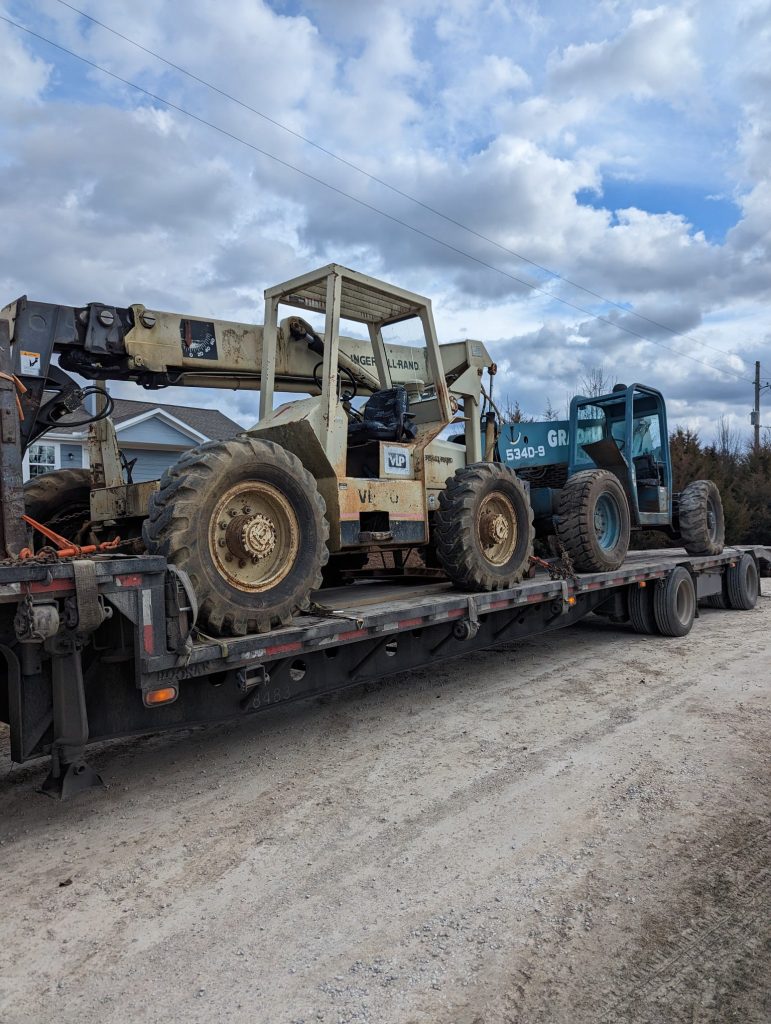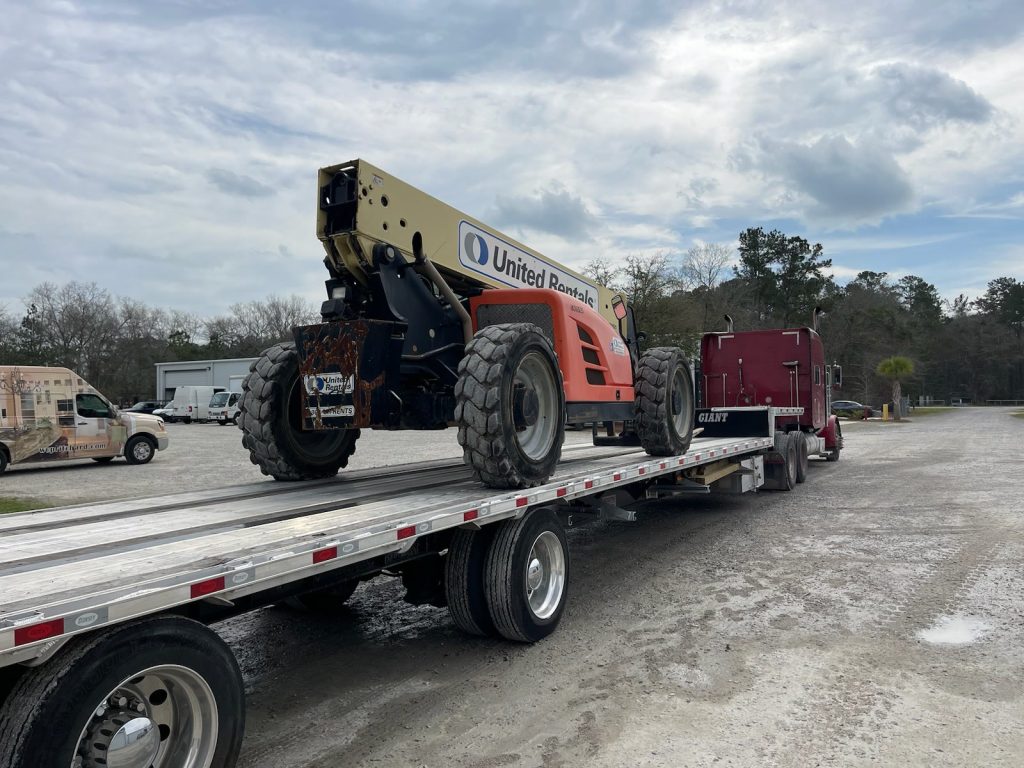What is a Step Deck Trailer? Compared with 3 Other Trailers
Freedom Heavy Haul can offer expedited Pickup and Delivery for any size shipment anywhere in the USA. Contact us today for No Hassle, No Pressure Pricing.
Step Deck Trailers, often called drop deck trailers, are a versatile and critical component in the transportation industry. These trailers are designed to transport loads too tall for standard flatbed trailers. The unique design of a step deck trailer, featuring a lower deck height, allows for the accommodation of taller cargo without exceeding legal height restrictions on roads. This makes them ideal for hauling a wide range of goods, especially those bulky or oversized.

In this article, you will learn what is a step deck trailer, its features and how is it different from other trailers.
What is a Step Deck Trailer Good For?
Here are some step deck trailer characteristics:
- Design and Purpose: Step Deck Trailers, also known as drop deck trailers, are designed for transporting oversized or tall loads that are too high for standard flatbed trailers, featuring a lowered deck to accommodate such cargo.
- Dimensions: These trailers typically have a lower deck height of 38 to 42 inches, and come in various lengths, usually ranging from 48 to 53 feet, with a standard width of 8.5 feet.
- Cargo Adaptability: They are particularly suited for hauling tall equipment, oversized items, and bulky construction materials, offering a versatile solution for loads that exceed height restrictions on regular flatbeds.
Key Dimensions of a Step Deck Trailer
The dimensions of a step deck trailer are crucial for understanding what type of cargo it can accommodate. Typically, these trailers come in various lengths and widths, offering flexibility to meet different transportation needs.
Maximum Height of Step Deck Trailers
The height of the lower deck is significantly less than that of a standard flatbed, usually around 38 to 42 inches off the ground. This lower deck height allows for the transportation of items up to 10 feet tall without surpassing legal height limits.
Standard Lengths of Step Deck Trailers
Step deck trailers are available in various lengths, usually ranging from 48 to 53 feet. This length provides ample space for a wide variety of cargo types.
Width Specifications for Step Deck Trailers
The standard width for a step deck trailer is 8.5 feet, similar to flatbed trailers. This width is suitable for a broad range of cargo, especially wide or irregularly shaped items.
Types of Cargo Suitable for Step Deck Trailers
Step deck trailers are incredibly versatile when it comes to the types of cargo they can transport. Their design makes them ideal for oversized or tall items that would not be legally permissible on a standard flatbed due to height restrictions.

Common Goods Transported on Step Deck Trailers
Due to their unique design, step deck trailers are capable of carrying a variety of large and heavy items, often used in industries such as construction, agriculture, and manufacturing.
Transporting Heavy Machinery
Heavy machinery such as bulldozers, excavators, and tractors are typical cargoes for step deck trailers. Their lower deck height provides the necessary clearance for such tall equipment.
Carrying Oversized Items
Oversized items like prefabricated building parts, large industrial components, or wind turbine blades often require the unique dimensions that step deck trailers offer.
Shipping Construction Materials
Construction materials, including steel beams, lumber, and large pipes, are easily accommodated on the expansive and sturdy platform of a step deck trailer.
Step Deck Trailers vs. Other Trailer Types
Understanding how step deck trailers compare with other types of trailers is essential for choosing the right equipment for specific cargo needs.
Step Deck Trailers vs. Flatbed Trailers
While both step deck and flatbed trailers are used for hauling large items, the key difference lies in their deck height. Step deck trailers have a lower deck, allowing them to carry taller items without exceeding height limits.
Step Deck vs. Double Drop Trailers
Double drop trailers have an even lower middle section than step deck trailers, making them suitable for extremely tall items. However, they have less usable space compared to step decks.
Step Deck vs. Lowboy Trailers
Lowboy trailers have a deck that’s extremely close to the ground, ideal for very tall and heavy items. Step decks, while versatile, don’t offer the same height accommodation as lowboys but are more adaptable for a variety of cargo types.
Pros and Cons of Using Step Deck Trailers
Step deck trailers offer several advantages in cargo transportation but also come with certain limitations.

Advantages of Choosing Step Deck Trailers
Their lower deck height makes them ideal for transporting tall items while adhering to height restrictions on roads. This versatility in handling different cargo types makes them a popular choice in various industries.
Challenges and Limitations of Step Deck Trailers
One of the main challenges of using step deck trailers is the need for specialized loading equipment, like forklifts and cranes, due to their design. Additionally, their large size can make maneuvering in tight spaces a challenge.
Operational Aspects of Step Deck Trailers
Operating a step deck trailer requires specific considerations, especially when it comes to loading and unloading, as well as ensuring the safety and security of the cargo.
Effective Loading and Unloading Techniques for Step Deck Trailers
Due to the lower deck height, loading and unloading of tall items is more feasible on a step deck trailer, but it often requires the use of specialized equipment like cranes or ramps.
Maximizing Load Capacity on Step Deck Trailers
It’s crucial to balance the cargo weight evenly across the trailer to maximize capacity and ensure safe transportation. Understanding weight distribution is key to effectively using a step deck trailer.
Safety Measures and Best Practices
Securing cargo properly is vital to prevent shifting during transport. Using straps, chains, and load bars are essential for safety. Additionally, drivers should be trained in handling these larger trailers, especially when navigating through urban areas and tight spaces.
Financial Considerations for Step Deck Trailers
Cost considerations play a significant role in the decision to use step deck trailers. This includes not only the purchase or rental costs but also operational expenses like maintenance and fuel.
Cost Analysis of Step Deck Trailer Operations
Operating a step deck trailer involves various costs, including fuel, maintenance, and potentially higher insurance premiums due to the specialized nature of the cargo. These costs should be weighed against the trailer’s benefits in transporting oversized or tall items.
Regulatory Compliance for Step Deck Trailers
Adhering to regulations and laws is critical in the operation of step deck trailers, especially given the variety and size of the cargo they carry.
Understanding Transportation Laws and Regulations
Operators must be well-versed in state and federal regulations regarding height, weight, and load securing requirements. Compliance is essential to avoid fines and ensure safe transportation.
Permits and Documentation for Hauling with Step Deck Trailers
Certain types of cargo may require special permits, particularly if they are oversized or exceed standard weight limits. Proper documentation is crucial for legal and hassle-free transport.







